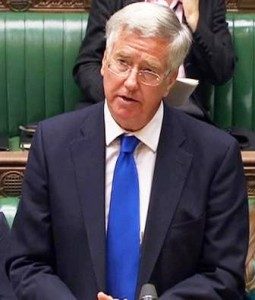
Fallon: Particular interest in SDT reform
The Solicitors Regulation Authority (SRA) revealed today that its investigation into Leigh Day cost £3.1m and also published correspondence that showed the close interest ministers took in the case.
The SRA has been deflecting questions about how much the failed prosecution of Leigh Day cost, and what influence the government had on the regulator’s work, but today published details of both.
The correspondence with the Ministry of Justice (MoJ) and Ministry of Defence (MoD) came as a surprise because SRA chief executive Paul Philip had previously seemed determined to keep this private, arguing that publishing it would impede the regulator’s ability to speak to government departments over issues of policy.
He recently shrugged off the loss of the case as “just one of those things”.
The highly politicised case related to the conduct of Leigh Day and three of its lawyers in acting for Iraqi nationals at the Al-Sweady inquiry, which cleared British soldiers of the most serious allegations of unlawful killing after a firefight during the Iraq war in 2004, but found there had been some mistreatment of detainees.
The SRA said today that it spent £222,000 on its initial investigation, £1.9m on the prosecution before the Solicitors Disciplinary Tribunal (SDT), and a further £972,000 on the High Court appeal. All figures include VAT.
In addition to its internal team, the SRA used City law firm Simmons & Simmons and Tim Dutton QC.
The SRA has still to pay Leigh Day’s costs of the appeal, which are subject to a detailed assessment.
The SRA said in a statement: “Our costs – primarily made up of legal fees – reflect the complexity and size of the investigation. The work on this case was completed within our usual budget provision for our disciplinary work.”
The correspondence revealed some of the scale of the case – a single disclosure request resulted in the SRA receiving 172,000 electronic documents to review.
It said it was putting “relevant” correspondence into the public domain, but that this did not include case evidence and case correspondence with the MoD as the complainant, “in line with usual practice”.
The 125 pages – much of which is repetitive email chains – show that ministers and officials took a close interest in how the SRA’s investigation was progressing.
The MoJ cited its role in maintaining trust and confidence in the legal regulatory regime as one of the reasons for its involvement.
From what has been published, there is no evidence of the MoJ or MoD demanding that the regulator take particular actions or that the SRA revealed any confidential or privileged information, although what it did provide was not in the public domain at the time.
One email from an MoJ official acknowledged that “as always, I understand there is a limit to what you can share”. Another said he did not wish “to influence the content or scope of your investigation”.
At the same time, in one exchange, an MoJ official sought information about the scope of the investigation and whether it was looking at how the firms found their clients and investigated the authenticity of their cases.
SRA executive director Crispin Passmore replied that in general there was nothing wrong with firms advertising or seeking clients proactively and confirmed that investigation was a wide one.
The official replied: “I think ministers want to know that you are looking at everything from start to finish!”
Mr Passmore responded: “We are! The challenge (as ever I suspect) is that the more we look at it widely and from start to finish the longer it takes and the harder we get challenged by the firms. That is inevitable but it is also incompatible with us doing it to a timescale that public and minister [sic] might prefer!
“Ministers can rest assured we know how important it is that we do a very good job on this and that public has to have confidence in our investigation and outcome of it. That doesn’t lead to any particular answer but it does mean that we know how important it is.”
In January 2015 – two weeks after the SRA publicly confirmed that it was investigating the concerns expressed by then defence secretary Michael Fallon about the conduct of Leigh Day and Public Interest Lawyers – there was an attendance note from SRA executive director David Middleton about a progress update he had given to an MoJ official.
He gave an overview of the issues the SRA was facing, adding: “She made clear that there is no intention to influence the SRA’s independent investigation. She said there is a huge interest within government in the fact that the SRA is investigating.”
The SRA also used this interest to pursue its wider agenda of full independence from the Law Society and changes in the way the SDT operates, in particular lowering the standard of proof to the civil standard and ending solicitor-majority panels.
It is also seeking an increase in its own fining power beyond £2,000 so that more cases can be handled without a referral to the tribunal.
Letters to and from Mr Fallon – who said the issues around the SDT were “of particular interest” – indicate that it was drawing him into a dialogue the regulator was already having with the MoJ that it also raised in a meeting with him.
It also made the arguments in exchanges with Conservative MPs, including Johnny Mercer – who was chairing a defence select committee inquiry – and Chris Philp.
In the letter to Mr Mercer, Mr Philip wrote: “It is perhaps unsurprising that, taken together, the status of the SRA as part of the trade association and the perception that the tribunal operates in a way that could potentially work in the solicitor’s interest, risks undermining public protection and confidence in the system.”
Frances Swaine, managing partner of Leigh Day, said: “We welcome this transparency from the SRA with regard to the costs incurred by the regulator in prosecuting us.
“The partial disclosure of correspondence between the SRA and government points to the need for the regulator to be not only truly independent of government, but also to be seen to be truly independent to ensure the trust of the public as well as the profession.”














Leave a Comment